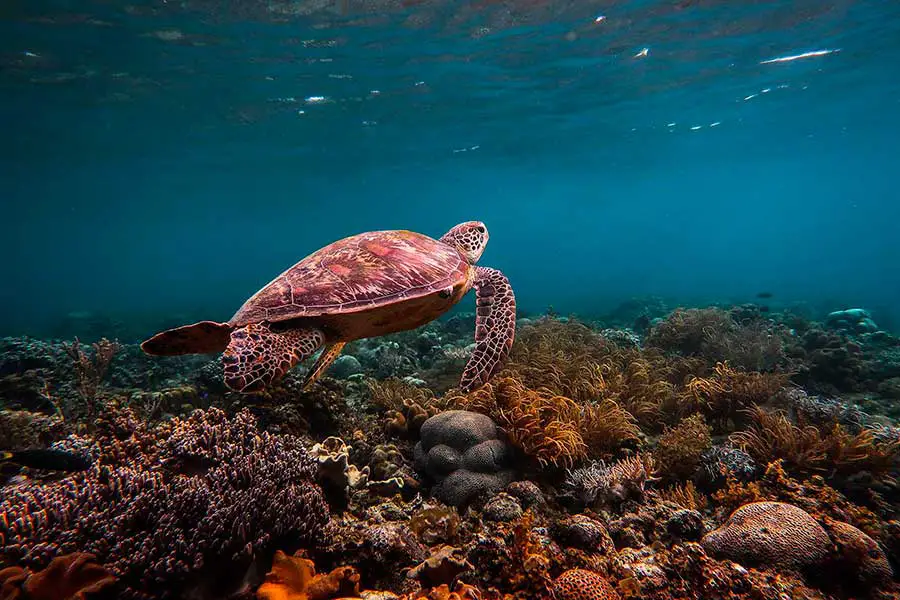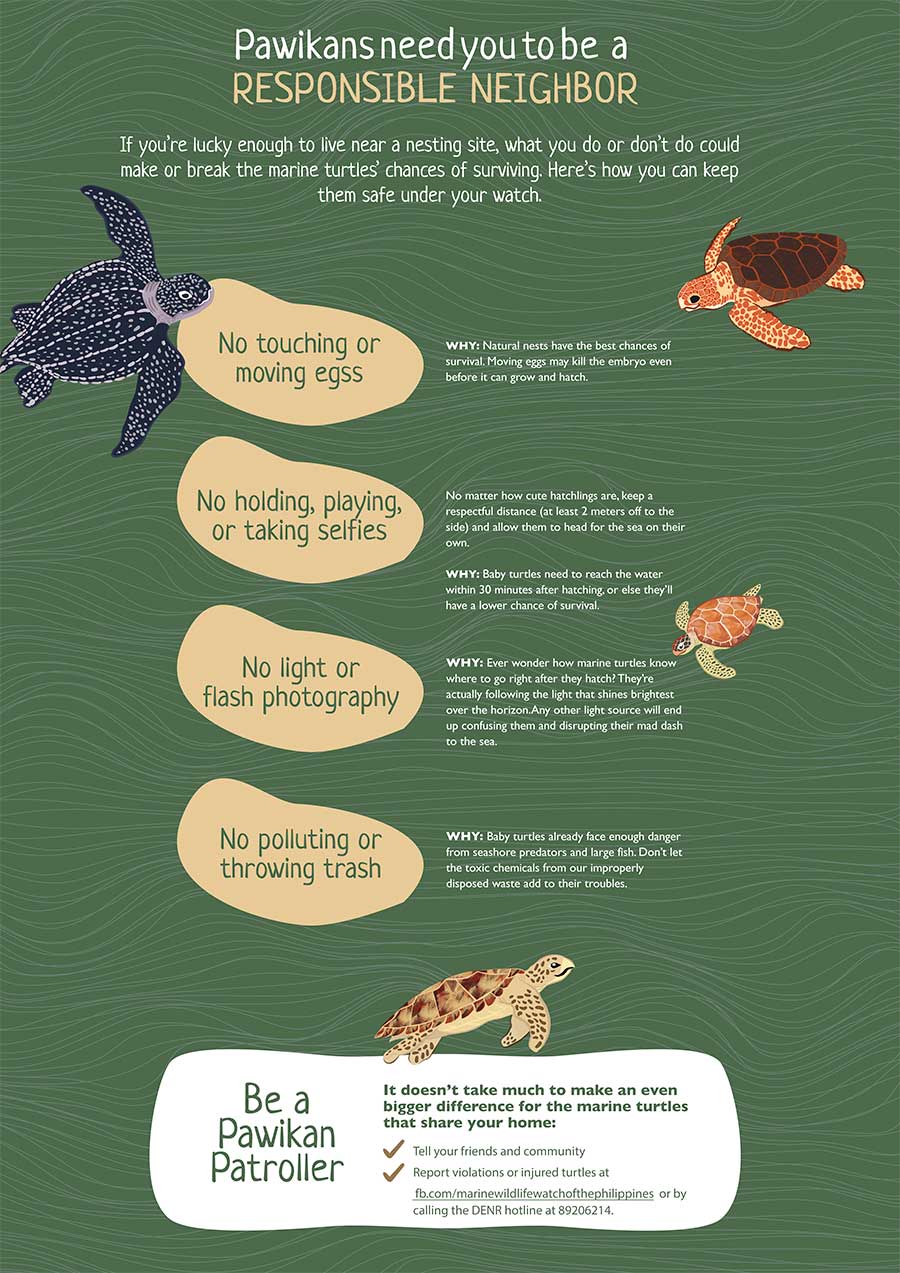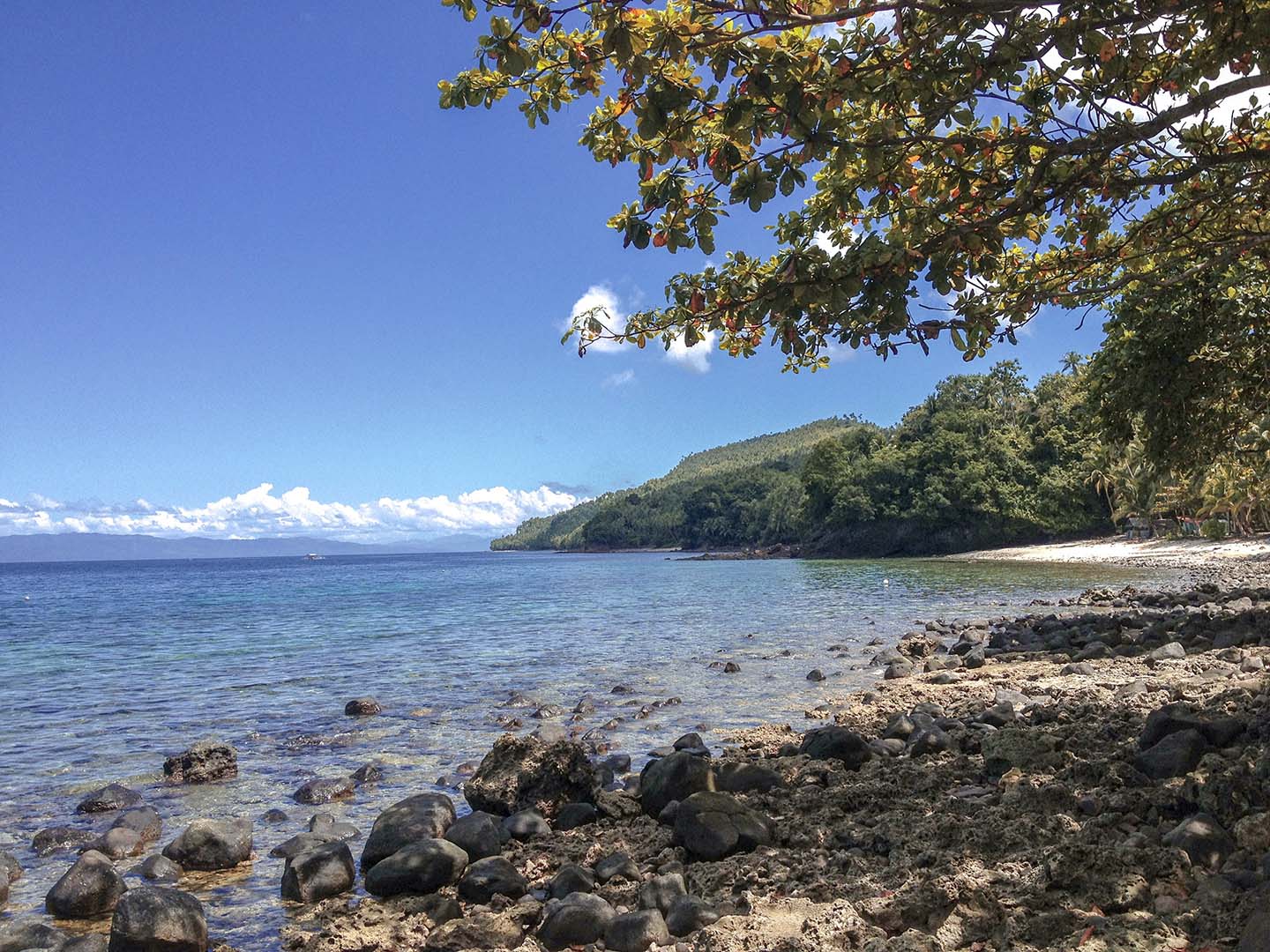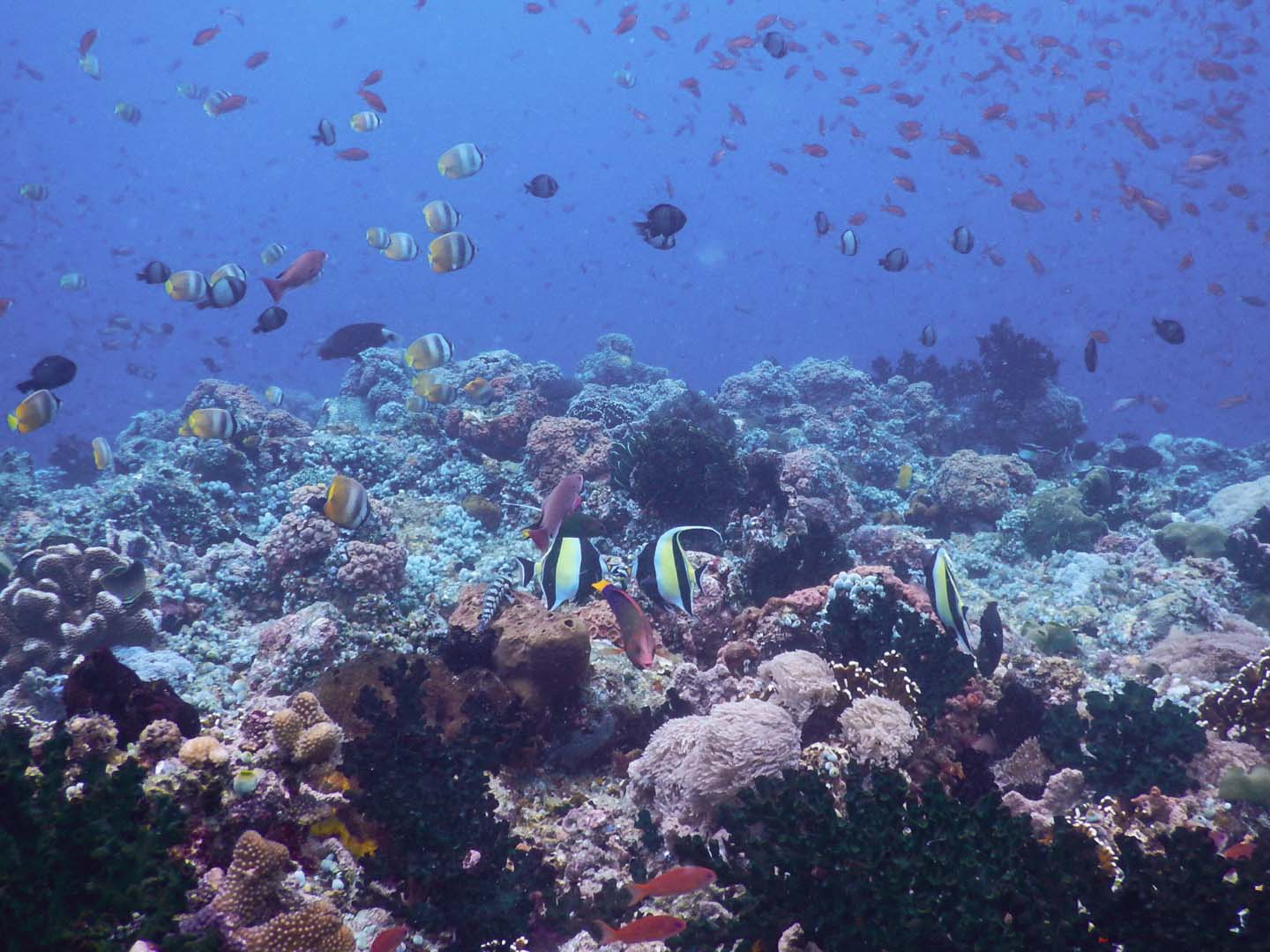Do you want to snorkel or scuba dive with sea turtles? In this post, I share with you, the best places to swim with sea turtles in the Philippines.
The Sea turtle, locally known as the Pawikan (pronounced as pa-wee-kan) is probably one of the most beloved creatures of the ocean. No matter how many times you have seen one, a sea turtle showing up underwater will always be a memorable encounter.
These gentle reptiles have brought delight to many scuba divers and snorkelers. Seeing them move gracefully and swim effortlessly in the water will surely make you feel ecstatic. One cannot help but feel in awe around these species that have existed on our planet for millions of years.
Best Places to Swim with Sea Turtles in the Philippines
Sea turtles have been sighted frequently all over the Philippines. If you are lucky, you can unexpectedly encounter these beautiful creatures when you go island hopping, snorkeling, or scuba diving. However, if you don’t want to leave it up to luck, here are the best places to swim with sea turtles in the Philippines:
1. Apo Island in Negros Oriental
2. Apo Reef in Occidental Mindoro
3. Balicasag Island in Bohol
4. Moalboal in Cebu
5. Siquijor Island in the Visayas
6. Anilao in Batangas
1. Apo Island in Negros Oriental
Apo Island is a 12-hectare volcanic island off the coast of Negros Oriental. This island is one of the most popular tourist attractions in the province. Many have made their way to the island just to swim with the friendly turtles of Apo.
But it was not always like this. Many decades ago, the reef in Apo Island was suffering from unsustainable fishing practices and reef destruction. To address this see problems, Dr. Angel Alcala, a marine scientist from Silliman University, pushed for the establishment of Apo Island Marine Sanctuary.
These efforts paid off not just for Apo Island but also for the Philippines. The success of Apo Island as a protected area became a model for other sanctuaries established across the archipelago.
Today, Apo Island is home to over 615 documented species of fish, about 400 coral species. And of course the sea turtles!
Apo Island is a haven to many sea creatures and turtle heaven for many visitors. If you dream of swimming with sea turtles, Apo Island is a turtle-y awesome place to go.
Must Read: Ultimate Guide to Diving in Apo Island
2. Apo Reef in Occidental Mindoro
Apo Reef Natural Park, not to be mistaken as part of the Apo Island previously mentioned, is located in Sablayan, Occidental Mindoro. It is a Marine Protected Area encompassing 34 square kilometers and it is the largest atoll-like reef in the Philippines.
Apo Reef is considered to be one of the best places to dive in the Philippines. You can expect to not only swim with sea turtles but also sharks, manta rays and other pelagic sea creatures.
With the reef located just 2 hours away from Sablayan by boat, it has become a popular tourist destination for snorkelers, freedivers and scuba divers.
It is also interesting to know that the island, where the ranger station is located, is a known nesting site for pawikans in Apo Reef. If you’re lucky to stay on the island, you might even encounter a marine turtle laying her eggs or witness a newly born baby sea turtle enter the ocean.
Read More: Ultimate Guide to Diving in Apo Reef
3. Balicasag Island in Bohol
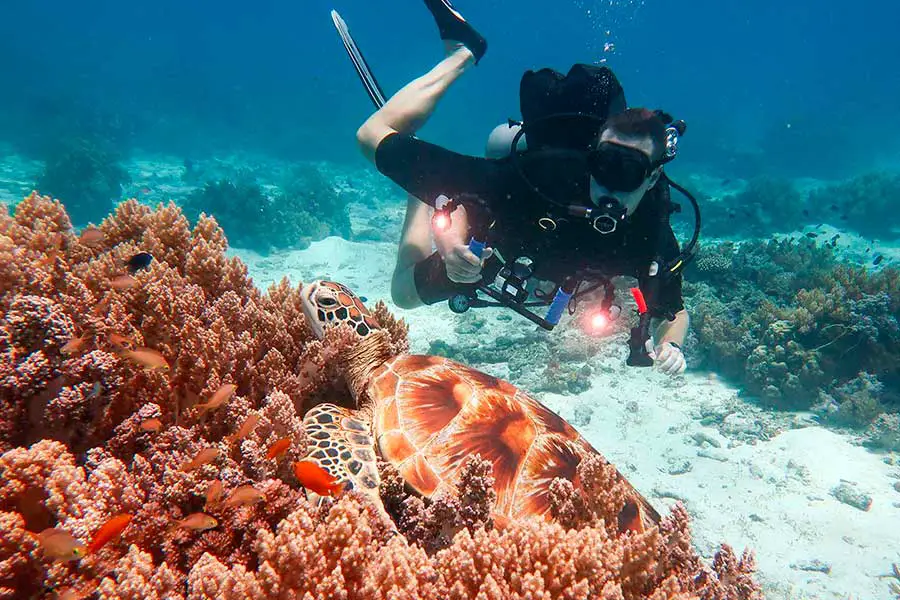
If you are visiting the province of Bohol to tick off Chocolate Hills and Tarsiers on your bucket list, you might as well include swimming with sea turtles on that must-do list.
Just a 30-minute boat ride from Alona Beach is the beautiful island of Balicasag. With white sand and turquoise blue water, Balicasag Island is truly a sight to behold.
But what makes this island special are the countless turtles and the diverse marine life that thrive in this little slice of paradise in Bohol. Once you’ve experienced it for yourself, you will understand why island hoppers, snorkelers, and divers love visiting this island.
In recent years though, to help protect the underwater inhabitants of Balicasag, the local government has put a limit on the number of people who can visit the island. So if you do want to swim with sea turtles in Bohol, make sure to plan ahead of time.
Read More: Ultimate Guide to Diving in Balicasag Island
4. Moalboal in Cebu
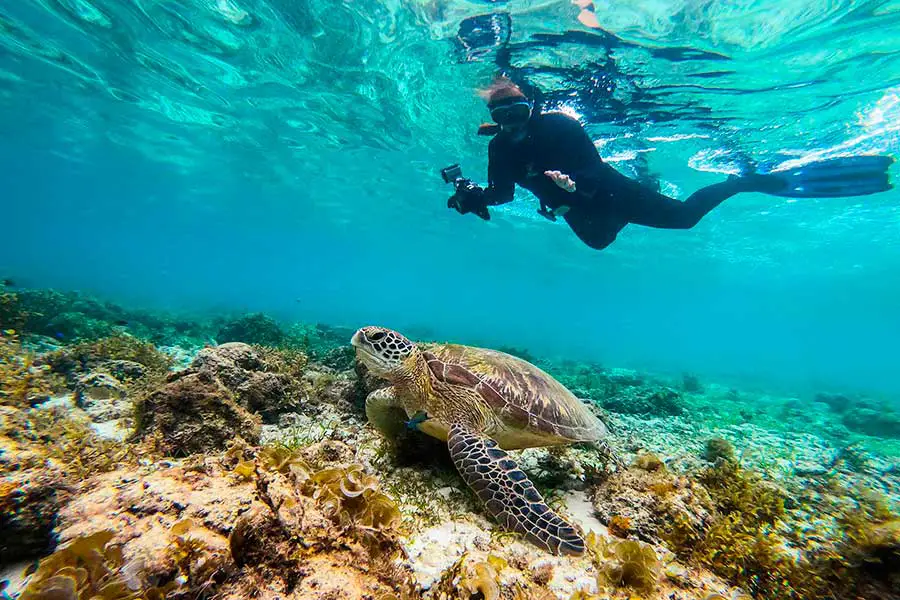
Moalboal is most popular for the millions of sardines that live just off the coast of Panagsama Beach in Cebu. But what a lot of people forget to mention are the marine turtles you will encounter just a stone’s throw away from the shore.
If you snorkel or dive in Moalboal you will surely encounter a sea turtle munching on the reef of Panagsama. Occasionally, you will even see a sea turtle swimming with the sardines which results in an even more unique experience.
The local government has declared this area a Sardine Protection Zone. But the protection covers not just the sardines but also other marine life that lives in the reserve. It is no wonder the sea turtles love it here!
So if you want to swim with sea turtles AND a millions sardines, you should head over to Moalboal, Cebu.
Related Article: Sardines Run in Moalboal
5. Siquijor Island
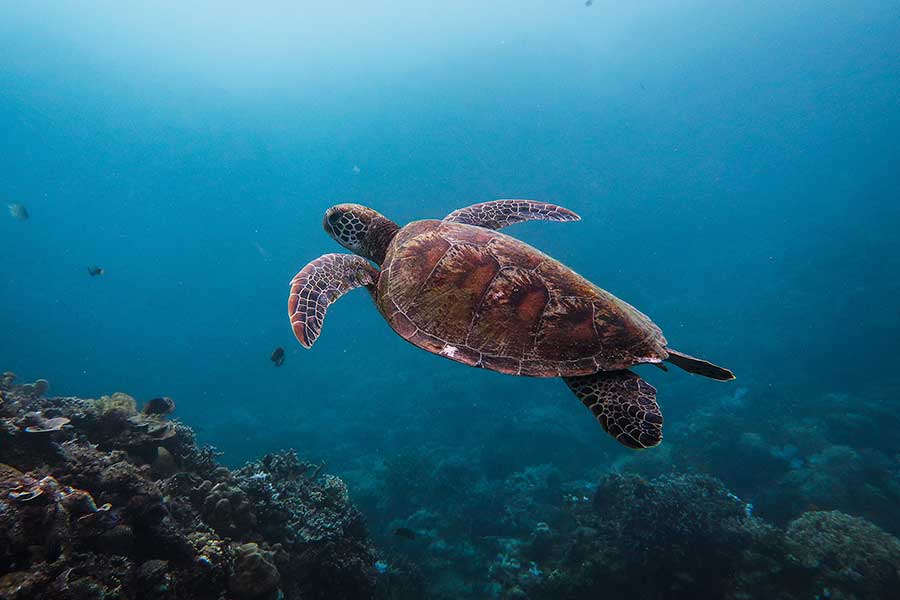
Siquijor is a tiny island province located in the Visayas region of the Philippines. It is the third smallest province of the Philippines. Neighboring the islands of Cebu and Negros and Bohol, it really is not surprising to find sea turtles here.
Siquijor has several sanctuaries around the island. Sea turtles have been spotted in Tubod, Tulapos, Caticugan, Maite Marine Sanctuaries. These spots are the best places to swim with sea turtles in Siquijor.
The underwater terrain of Siquijor has slopes, walls, caves, overhangs, and even canyons, so you’ll never know when a sea turtle will just swim out of nowhere. The marine life around Siquijor is abundant and diverse too and you will be left wanting more.
While the turtles here are not as abundant as the neighboring Apo Island Siquijor Island is less touristy which you might find more attractive and enjoyable.
Read more: Ultimate Guide to Diving in Siquijor Island
6. Anilao, Batangas
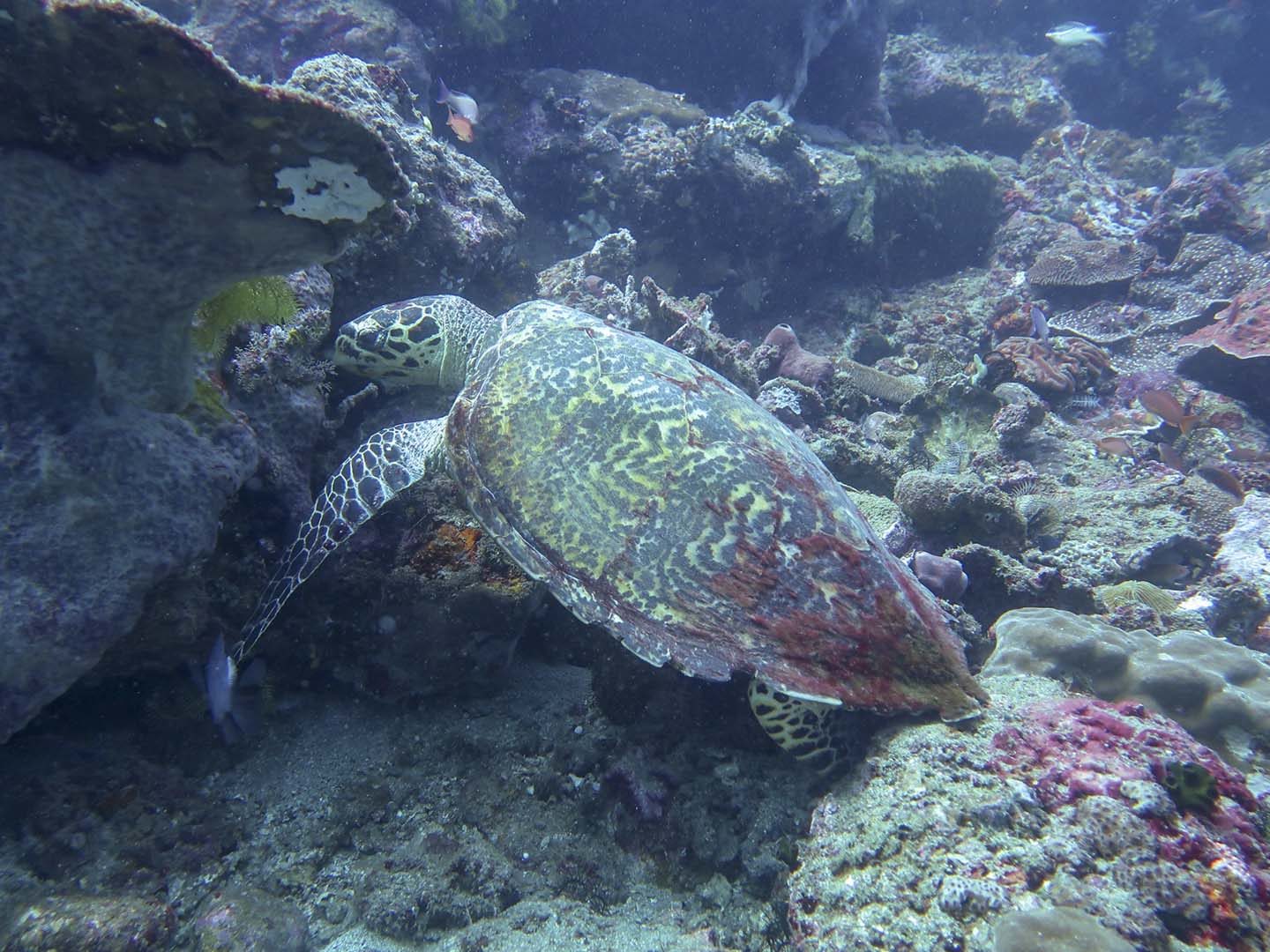
Located 3 hours south of Manila, is one of the most popular dive destinations in the Philippines: Anilao Batangas. With more than 50 dive sites in the area, the chances of you encountering sea turtles while scuba diving and snorkeling are highly probable.
Having visited Anilao several times, I can confirm that you can swim alongside them underwater. I must admit that while sea turtles are not as common as the previous locations mentioned on this list, they can still be found in Anilao. I can only deduce that this is because of the amount of human activity that happens in the area. Nonetheless, I’ve included it on the list because it is one of the most convenient places you can go to especially if you live in Luzon.
And should you not encounter a sea turtle on your visit, Anilao has one of the best reefs in the area. That in itself would be worth the trip.
Read more: Ultimate Guide to Diving in Anilao, Batangas
No one can control a sea turtle’s behavior or its schedule, so the sightings are never guaranteed. But if you do get a chance to dive and snorkel in these places, there is a big likelihood you’ll see a marine turtle.
If you notice, most of these places are Marine Protected Areas (MPA). Turtles love feeding and swimming in these spots because they know they will not be harmed. These MPAs shows how important these sanctuaries are for our sea turtles and oceans to thrive.
So even if you don’t meet a pawikan in these places, don’t feel too bad. You will still be rewarded with beautiful reefs. And maybe you will even meet the sea turtle’s friend, named “Nemo,” instead.
Do you love sea turtles or know someone who does? Check out these articles:
10 Best Adopt a Sea Turtle Programs That Are Turtley Awesome
Unique Sea Turtle Gifts: 31 Gift Ideas for Turtle Lovers
Frequently Asked Questions About Sea Turtles
Here are some frequently asked questions about sea turtles that you might want to know before you swim with them.
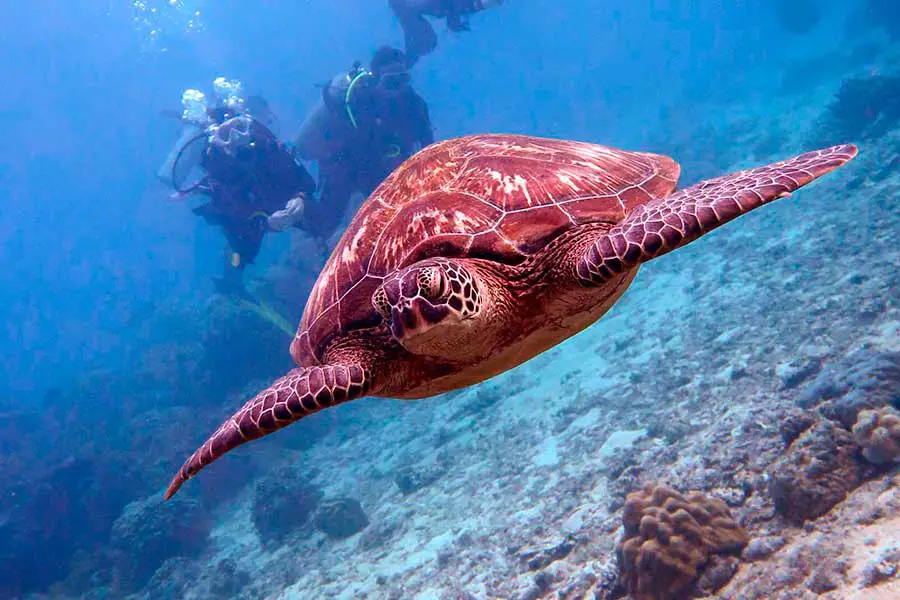
What are the 7 different species of sea turtles?
There are seven species of sea turtles in the whole world, namely:
Green Sea Turtle (Chelonia mydas)
Olive Ridley Sea Turtle (Lepidochelys olivacea)
Hawksbill Sea Turtle (Eretmochelys imbricata)
Leatherback Sea Turtle (Dermochelys coriacea)
Loggerhead Sea Turtle (Caretta caretta)
Kemp’s Ridley Sea Turtle (Lepidochelys kempii)
Flatback Sea Turtle (Natator depressus)
What sea turtle species can be found in the Philippines?
Out of these seven species of sea turtles, five can be found in the Philippines!
The green sea turtles, olive ridley sea turtles, hawksbill sea turtles, and leatherback sea turtles have been known to swim and nest within the Philippines. And even though the loggerhead sea turtles have no records of nesting on the islands, they have been spotted within the Philippine ocean territories as well.
So you can just imagine the probability of meeting a sea turtle while snorkeling or scuba diving in the Philippines is very high.
How long do sea turtles live?
Sea turtle or pawikans have a natural lifespan of 50 to 100 years!
Are sea turtles friendly?
Sea turtles have many endearing qualities that people love. They are beautiful and quiet creatures that tend to mind their own business rather than approach humans. Their behavior towards humans can be described as tolerant rather than friendly.
In some areas where they are used to seeing humans, they will not mind if you approach them. However, in other places, they are easily spooked and they will try to get as far away as possible from humans.
Do sea turtles bite?
The probability of sea turtles biting you is highly unlikely. They prefer to eat food from the ocean, and not humans. If they do bite, it is most probably because you did something that you shouldn’t have been doing in the first place- like hand-feeding them or touching them.
They are not known to attack human beings. But if they do, their bites can be painful and can cause injury. After all, they do have strong jaws and sharp beaks that they use to eat hard-shelled organisms.
Threats to the Sea Turtles in the Philippines
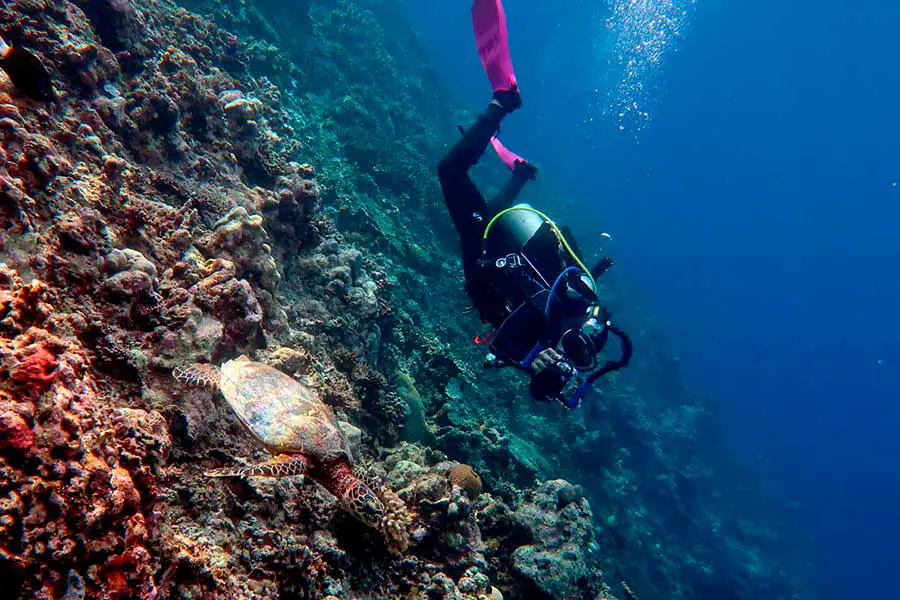
While it is exciting to swim with sea turtles, you need to remember that these creatures are classified as endangered species. The hawksbill turtle is even classified as critically endangered which means they’re facing an extremely high risk of extinction!
The sea turtles in the Philippines face various threats throughout their lives. Every time you see one sea turtle swimming in the ocean, remember that about 1000 other sea turtles never made it to adulthood.
Aside from their natural predators like tiger sharks and killer whales, the sea turtles’ biggest threat is mankind.
Humans love poaching turtles for their meat and their shells. In some countries, even the eggs are taken from nests for human consumption.
Humans have also been the main cause of the degradation of sea turtles’ habitat. The development of coastal areas has disturbed the breeding process of sea turtles. And reefs, where they find food, are either bleaching or completely destroyed.
Many sea turtles die by getting entangled in nets that fishermen have left at sea. Ingesting the pieces of plastic in the ocean has also been fatal to marine turtles.
Help sea turtles by reducing your plastic consumption. Here are 101 Ways To Say No To Plastic Everyday.
Sea Turtle Conservation in the Philippines
The constant human interferences disrupt the life of sea turtles.
So before you swim or interact with them you might want to think again of how you are negatively affecting these endangered species.
Swimming with sea turtles in the Philippines is not illegal. But the pawikan species are usually at a disadvantage in these interactions. When both locals and tourists do not know how to behave in these encounters, they end up harming the sea turtles.
Thankfully, the sea turtles in the Philippines are protected under the Wildlife Resources Conservation and Protection Act (Republic Act No. 9417) of 2001 or the Philippine Wildlife Act.
In support of this act, the Department of Environment and Natural Resources (DENR) together with conservation partners have come up with guidelines and procedures to ensure the protection of the marine turtles.
When you encounter a sea turtle in the ocean or on land there are best practices you should follow to ensure the pawikan is not harmed.
What do you need to do when swimming with sea turtles?
If you get the chance to meet a marine turtle while diving or snorkeling, there are several things you can do for safe interactions with the sea turtle:
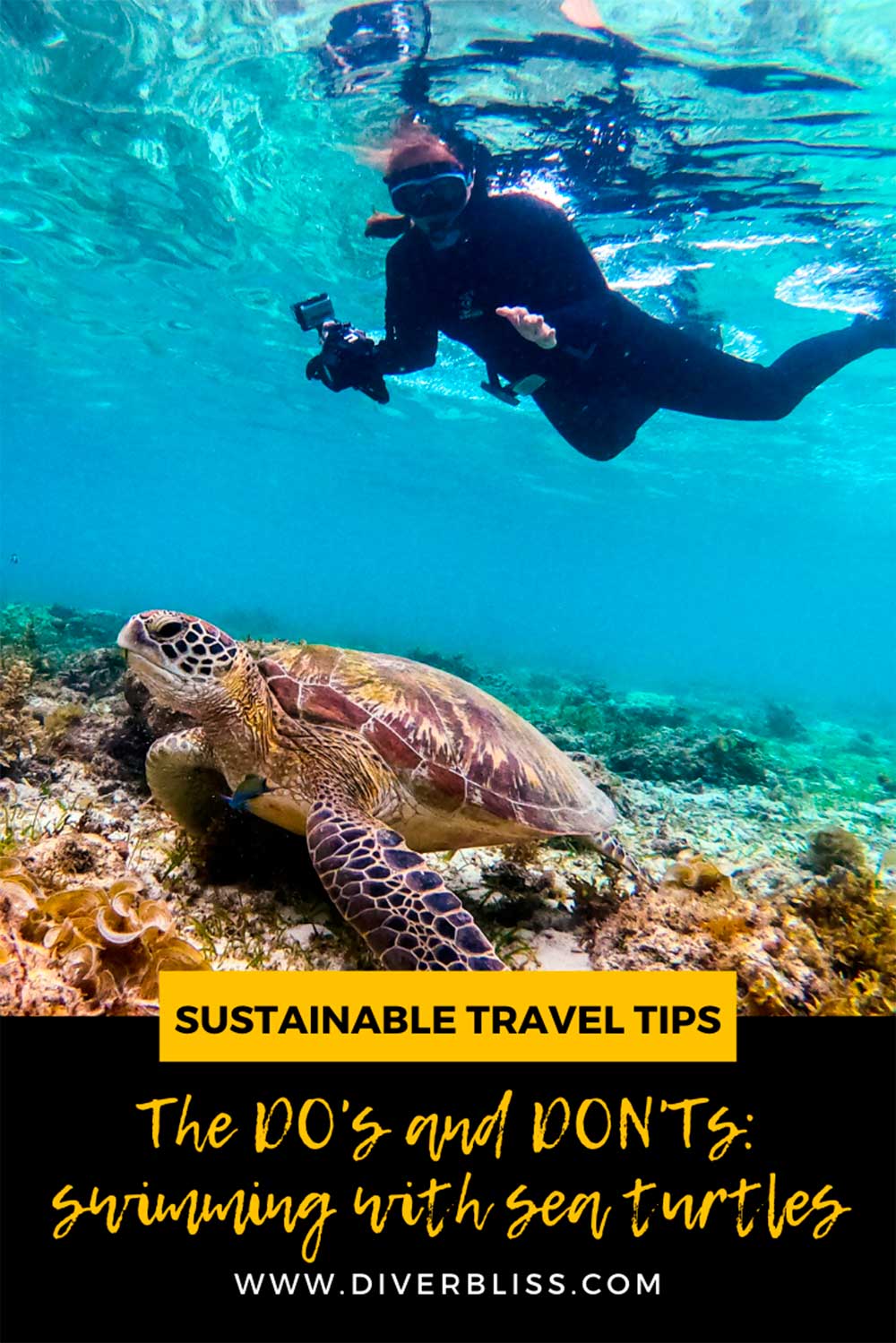
- Do not touch, pet, grab, or ride a sea turtle.
- Maintain a minimum distance of 2 meters.
- Do not make loud noises. If you are snorkelling, minimize splashing around or talking with a friend.
- Always approach the marine turtle from the side so it sees you. Give them a clear path ahead of them.
- If you encounter a sea turtle resting in a cave or an overhang underwater, give them space to swim up. Turtles need to go to the surface to breathe air.
- Do not chase a sea turtle.
- Do not try to feed the marine turtle. They know how to look for their own food. And they might bite you.
- Pick up plastic waste so the turtles do not eat them by accident.
- Avoid excessive flash photography when photographing sea turtles. Do not point the flash directly into their eyes
What to do if you see a sea turtle laying eggs?
If you are lucky enough to witness a sea turtle laying her eggs, here are the things you need to remember:
– Do not disturb the marine turtle. Let her lay all of her eggs on her own. She will not need your help.
– Remain silent and observe from a distance of at least 2 meters to avoid stressing the marine turtle.
– Do not point lights or use flash photography on the sea turtle while she is laying her eggs.
– Do not touch, pet, grab, or ride the marine turtle.
– Do not touch the sea turtle nest.
– Do not dig out or play with the sea turtle eggs as you could damage the yolk and kill the developing embryo.
– Call the local authorities so the eggs can be protected. If the nest needs to be transferred to a safer area or needs protection from wild animals, they will know how to do this properly.
One interesting fact about sea turtles is that they have some sort of built in”homing device”. Pawikans have the unique ability to return to the beach where they were born. And when they do, they lay eggs of the next generation of marine turtles.
Sea Turtles spend 96% of their lives in the ocean. When you see a pawikan on land, it is most likely a female sea turtle who needs to lay her eggs. Depending on the species of marine turtles, there will be 60 to 200 eggs laid in sand nests along the beach.
What should you do when you encounter sea turtle hatchlings?
After 45-75 days, the sea turtle’s eggs should hatch, and the hatchlings should emerge from the sand.
The eggs hatch at night. And the baby sea turtles’ natural instinct is to use moonlight to find their way to the ocean.
If you are lucky to see such a miracle, here are the things you need to do:
- Do not shine a light on them and keep the surrounding areas dark. The hatchlings use light they see on the horizon as a guide to where they need to go.
- Do not gather them to put in a pail or basin. Putting them in containers will tire them out and reduce their chances of survival when released.
- No matter how cute they are, do not hold, play or take selfies with the sea turtles. You may take photos with no flash, as they make a mad-dash to the ocean.
- Make sure the hatchlings can crawl freely on the sand. You may clear the path from trash and debris that could harm them. But never pick them up and bring them to the sea.
- Hatchlings should be released immediately. It is illegal to keep them for any period of time or raise them in captivity.
What else can you do to save the sea turtles?
Sea turtles are such beautiful creatures that play an important role in our oceans eco-system. They need to be protected most especially from humans who have cause them more harm that good. If you love sea turtles, there are things you can do to further protect them.
Aside from following the guidelines for sea turtle interactions, you can avoid questionable tourism practices. Do not participate in delayed hatching releases. Sea turtles should not be kept in captivity as a tourist attraction.
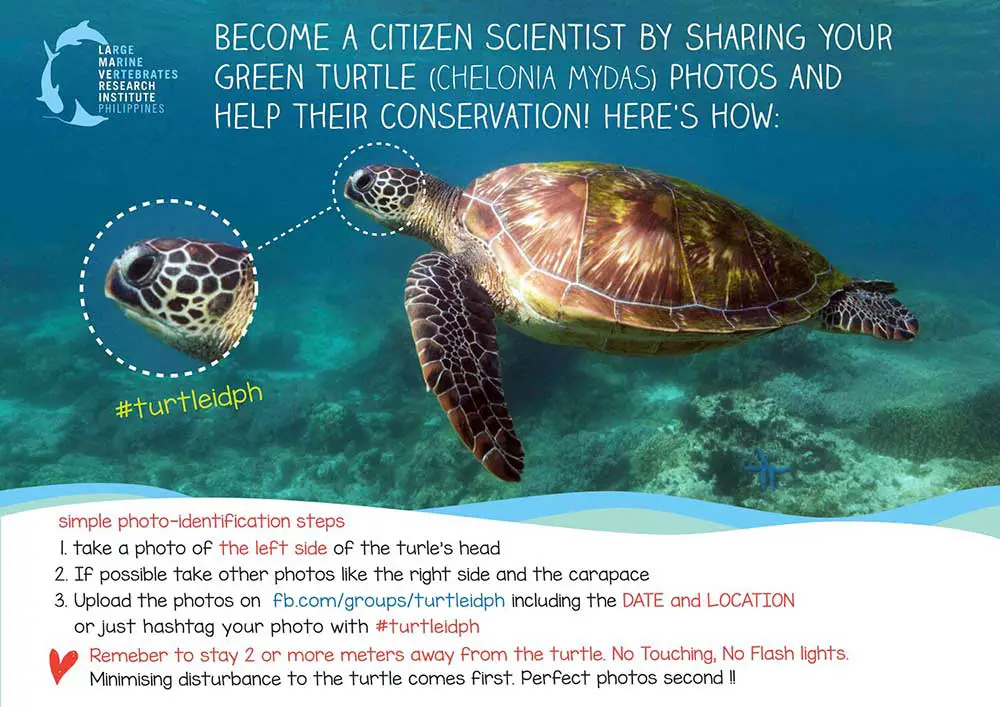
You can also become a citizen scientist for turtle conservation. If you have photos of sea turtles in the Philippines, you can contribute to Large Marine Vertebrates Research Institute Philippines (LAMAVE) turtle research program.
To report a sighting, capture, trade, captivity, death, by-catch, or stranding of protected marine wildlife like the sea turtle, you may send a message to Marine Wildlife Watch of the Philippines Facebook Page.
Do not purchase products made from marine turtles. Refuse single-use plastics. Raise awareness and share information about sea turtles. Do these simple things and you can help save the sea turtles one little step at a time.
Pin this for later!
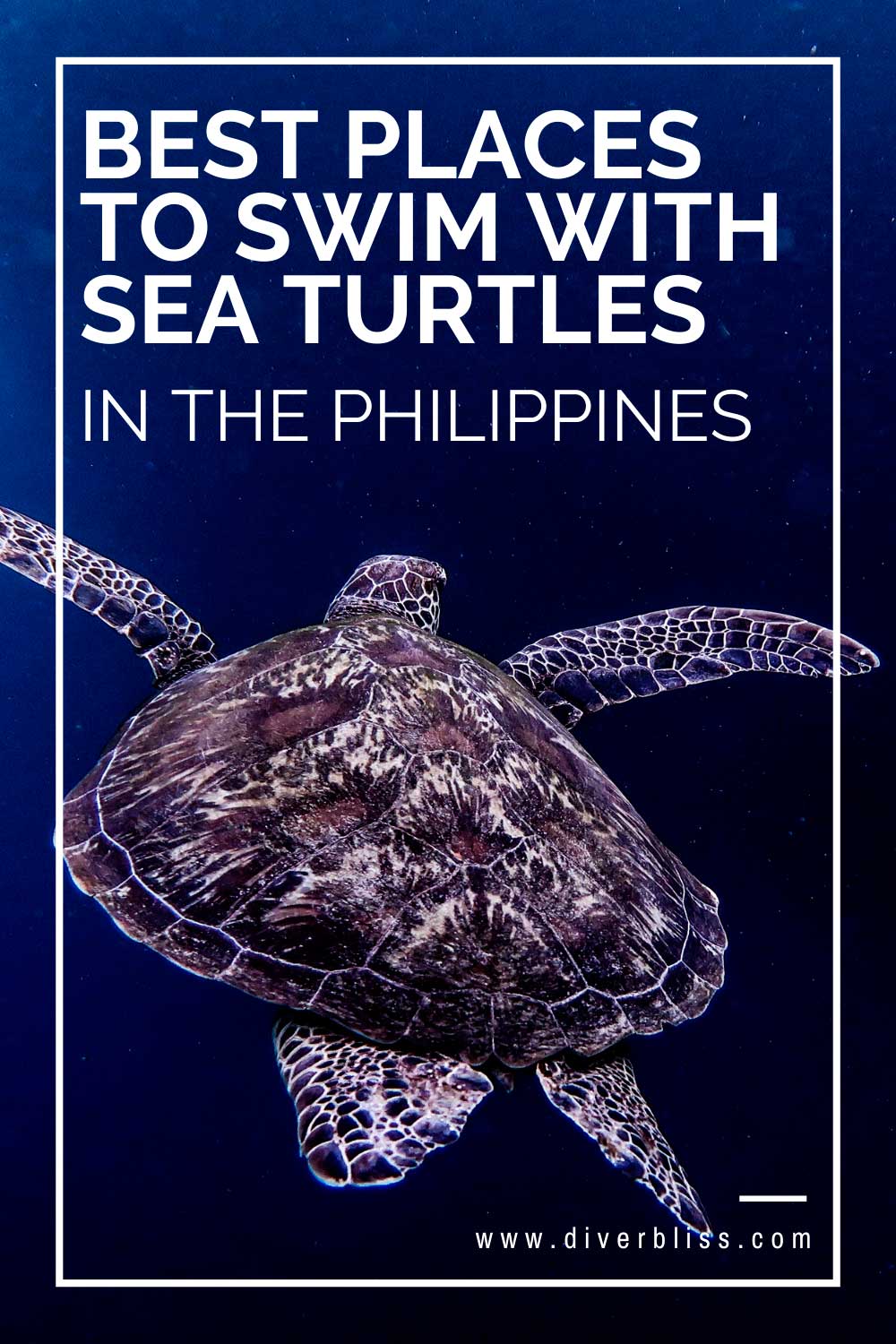
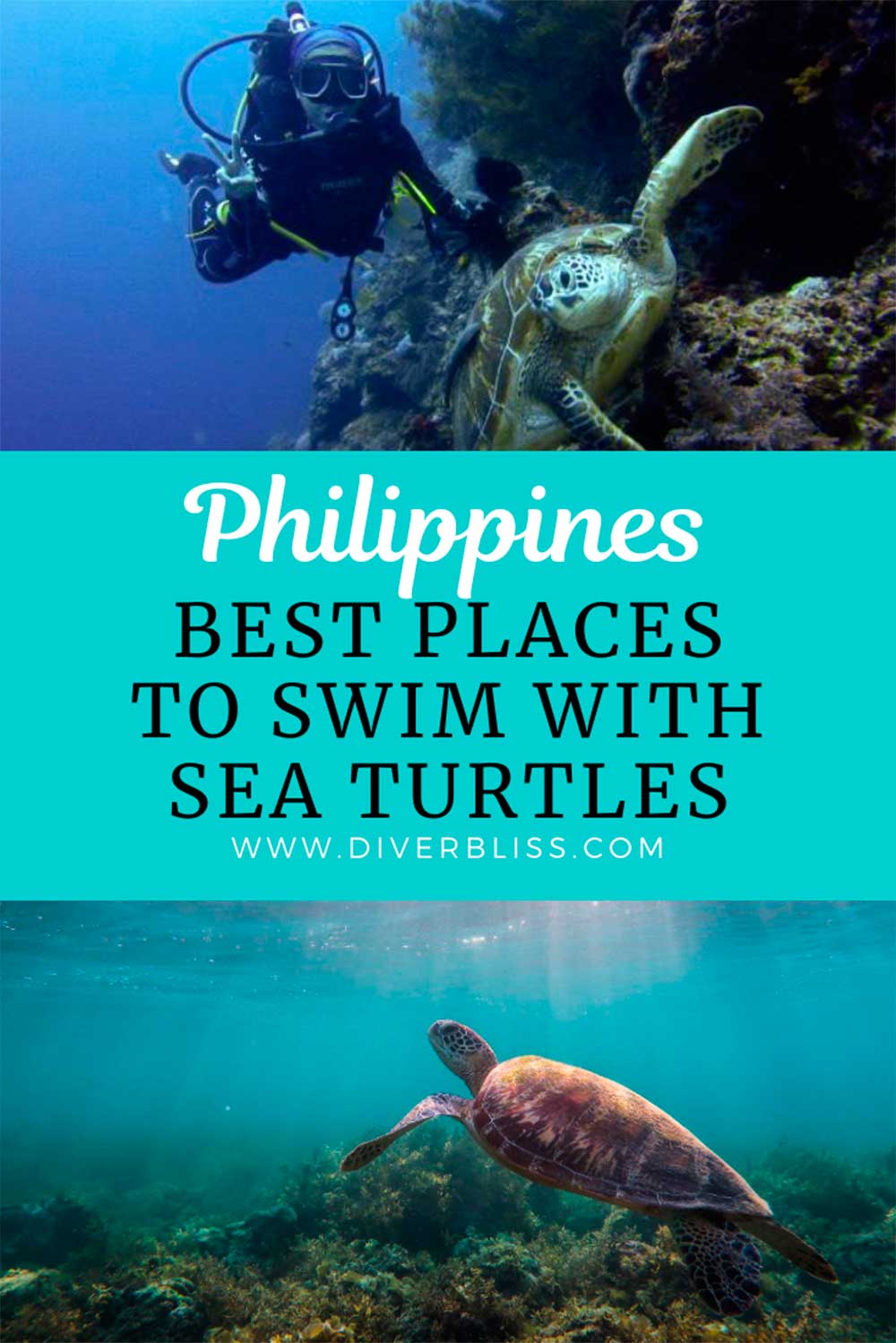
Have you visited any of these places and swam with sea turtles? Do you love sea turtles too? What can you commit to doing to help save the sea turtles? Leave a comment below!
